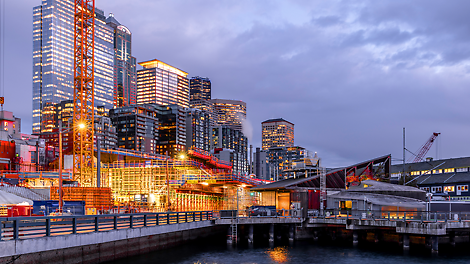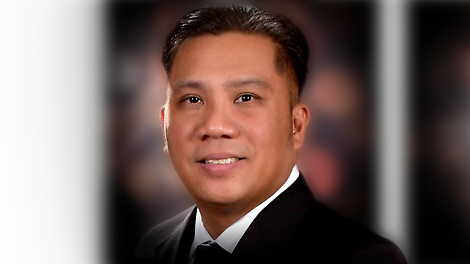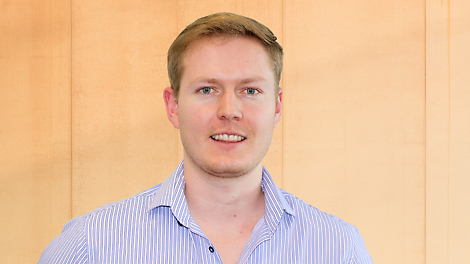
The aquarium was opened in 1977 on the Seattle waterfront and is now getting an impressive new 50,000-square-foot Ocean Pavilion. Through the public square of the expansion, everyone will soon be able to get a glimpse into the aquarium without even buying a ticket. The unique feature of the project? There are no straight walls. That's what made working on this building so complex. And that’s why the very best experts were needed.
Since we effectively create tailor-made scaffolding and formwork solutions while ensuring a high level of safety for the workers, the construction company Turner Construction approached PERI USA with this exciting project. A whole new kind of project that neither of us have done ever before in America. But with our experienced engineers and their various areas of expertise, any project can be successfully realised.
And then it was straight down to business and the hard work was just the beginning…
Concept phase: Where dreams became reality
The first phase consisted of creating initial concepts and mock-ups for the formwork and scaffolding.
Major focus: Understanding our client and their wants and needs.
What’s the best way to achieve that? Tim Cruz, Director of Engineering at PERI USA, knows the answer: “To understand what our client wants and needs, it’s important to talk and ask lots of questions because the whole project is built on this first phase. That’s why we had lots of meetings with them and the suppliers.” And that’s exactly where PERI made the difference. The team dealt intensively with the construction company and their wishes. From these valuable conversations, our engineers created the first mock-ups.
In the end, the concepts were very well received, highlighted the excellent skills of our engineers and ultimately led to us securing the contract.

Tim Cruz
Director of Engineering at PERI USA
“That was the starting point where one question kept us all up at night: Is this construction even buildable?”
Proposal phase: Global teamwork is the key
After the project was awarded to PERI, Tim had to clarify which skills were needed and who was responsible for what. It quickly became clear that, in addition to a large project management team, a small group was also needed to take care of the 3D design.
Major focus: Who had the availability and outstanding 3D know-how at PERI?
“A difficult project like this is only possible with the help of 3D models to illustrate how formwork and scaffolding would work best here”, says Tim. But even with 3D, the team wasn’t sure if it would work the way they wanted it to. What they needed was a team effort that included experts from all over the world with different expertise. And that’s exactly what PERI has. After a short search, they found Renier Mulder, Project Engineer from the PERI Middle East and Africa Engineering Competence Centre, who is an excellent 3D expert and therefore a huge help. “I love everything that has to do with 3D. So it was clear to me that I wanted to do this job”, says Renier. Under the guidance of Daniel “Dan” Burke, Engineering Team Lead at PERI USA, Tim and Renier mastered the demanding task.
Kyle Jackson, Head of the Engineering Competence Center, acted as the interface between the US team and the Competence Center, which is based in South Africa. The Technical Service Office (TSO) in the Philippines supported the US team with further engineering challenges.
This is a great example of what sets us apart: We have experts who work all over the world, but who pool their expertise in a global cooperation for such large projects.

Kyle Jackson
Head of the Middle East and Africa Engineering Competence Center
“Our collaboration on the project went on for about 1.5-2 years. The total number of hours shows how much engineering work went into it, namely an incredible 1,800 hours!”
Execution phase: Our engineers deep dive into solutions
Once all the tasks were assigned, the most complicated and the most exciting phase began. Why complicated? Because during this step it became clear whether the Ocean Pavilion could actually be built or not. And why exciting? Because there were a series of challenges that made the work all the more interesting.
Major focus 1: Finding a formwork and scaffolding that made the complex geometry work.
Easier said than done. For this job, the teams needed to communicate a lot with everyone involved and they had to be extremely creative to come up with great individual solutions. But the close cooperation between the transnational PERI offices made it possible! To accommodate the difficult shapes, a foam system was used in combination with our formwork system. Our engineers therefore had to calculate the exact size of the formwork panels so that the foam could be cut accordingly. Otherwise, everything would have to be redone, which would have been very time-consuming.
Major focus 2: Calculating the correct concrete pressure.
That was probably one of the biggest challenges during the whole project. Tim explains why: “The problem was that we didn't know at the beginning whether our formwork could withstand the pressure of the concrete. Since the concrete is liquid at first and hardens later, we had to calculate the correct concrete pressure. And that was a difficult task to solve.”
Major focus 3: Including a roadway in the construction site in the short term.
Short-term changes are normal on construction sites, but this one had it all! Much of the work on the site had already been completed, but then the road which runs adjacent to the site had to be incorporated to enable a continuous traffic flow. That created a lot of extra work for the team at the last minute. They eventually found a creative and out-of-the-box solution together. PERI UP scaffolding was used here, which enabled us to span the roadway cost-effectively and with the highest safety requirements.
Assembly phase: With precision to success
The next step on the construction site was to get to the heart of the matter: the assembly phase.
Major focus: Delivering the right material at the right time.
Due to the tight storage capacity, not everything could be delivered at once. So, while the systems were gradually engineered, the finished system parts were delivered and assembled one after the other. To make sure that everything went smoothly here, the team in the USA triple-checked the quantities of all systems. Because accuracy is our strength! And with the last delivery, the whole team did an amazing job.
Client expectations? Exceeded!
Although the project won’t be finished until early 2024, we’ve already exceeded the expectations of our client. “Turner Construction was really really happy with us. Be it the approach we took, how we collaborated or how we dealt with all the challenges. In the beginning, we weren’t even sure if we could manage a complex project like this, but we made it – and I’m really proud of us”, says Tim.
Kyle can only agree: “Turner was even so impressed that PERI USA got a whole lot of return work after that.”
Despite a project as complex as the expansion of the Seattle Aquarium, we are happy to have found the right solutions. And all thanks to our expertise, our courage to think out-of-the-box and the close collaboration with our client. We can’t wait to see the final result!
We are on site for you worldwide
Our support knows no borders - no matter where you are in the world. Simply select the website for your country and discover detailed information about our products, projects and contact details for our local contacts. We are always happy to assist you and look forward to helping you too.